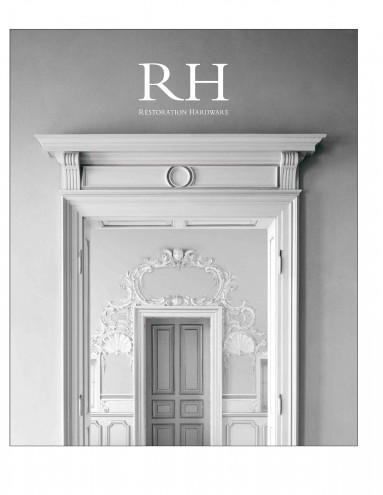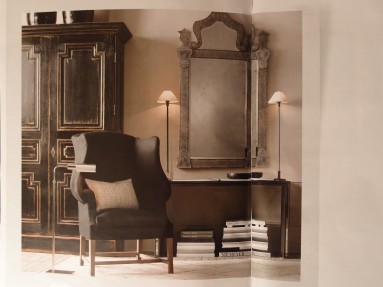[introduction here]
 In 1980, not long after a total solar eclipse bathed North Africa and West Asia in daytime dusk and, in entirely related events, the Norwegian oil platform Alexander L. Kielland collapsed into the North Sea, bringing with it more than half of its 212 man crew, and, precisely two weeks after the death of Marshal Josip Broz Tito, Mount St. Helen's launched the most extensive act of volcanic sabotage in North American history, Stephen Gordon opened the first Restoration Hardware store in Eureka, California.
In 1980, not long after a total solar eclipse bathed North Africa and West Asia in daytime dusk and, in entirely related events, the Norwegian oil platform Alexander L. Kielland collapsed into the North Sea, bringing with it more than half of its 212 man crew, and, precisely two weeks after the death of Marshal Josip Broz Tito, Mount St. Helen's launched the most extensive act of volcanic sabotage in North American history, Stephen Gordon opened the first Restoration Hardware store in Eureka, California.
The store, which sold authentically weathered and historically accurate home furnishings, was based out of Gordon's own home, much as the Costan Rican wasp will lay an egg on the belly of the Plesiometa argyra spider. From that egg, the emergent larva will first suck the blood of the host, as if of a house, before injecting it with a chemical that causes the spider to weave a new web, not one of domesticity or the reproduction of its own existence, but of the necessary infrastructure for the transmission of something entirely hostile to it. Such was the relation of Restoration Hardware to the American home: using it as cover, avatar, and justification, the Hardware advanced its bleak mission, until one day, having secured its dizzying scope of infiltration and no longer needing its host, it sucked dry the enfeebled home and took its place at the center of this queer web. And over the next three decades, it was to spread, and spread, and spread.
In 2008, Restoration Hardware & Baby launched. Having forged collaboration with the most advanced parasite previously known to the human species, namely, itself, the Hardware's eventual domination was assured. Those who recognized the significance of this were never seen again, and the traces of drool on, and suspect “weathering” of, their previously normal furniture was ignored by baffled investigators.
Still, there was that perennial problem: the Hardware could not make itself ex nihilo, even with the horde of infants marshaled for the cause. It needed labor, it needed consumption, it needed circulation, it needed “breaking in.” Or perhaps it was the other way around: capital that needed the Hardware. Either way, what we know is that it shifted the entirety of its production overseas, to factories in India, Vietnam, and China, assuring the ever-wider circuits of its ceaseless passage through empire's nodes.
Meanwhile, back on the home continent, our worst fears were confirmed when, on the outskirts of the city, we were to learn that the 158 photos of various arrangements of furnishings in the 744 page Fall 2012 Source Book were, like Pickman's Model, no artist's renderings in a studio. They were documentary records of the Ur-house, the wasp itself and its 158 rooms.
And to make things even worse, we were only to learn this fact once we had already stepped into this pseudo-salvaged house of hell.
PRELUDE
[No description]
I noticed, with a certain degree of concern, that the armoire - later, we were to be informed that it is the Montpellier armoire, but at this point, we were in the dark regarding its name, purpose, and intentions - was well and truly worn. Along the edges of its raised paneling, its irregular rectangles topped with a smaller rectangle as though a button to be pushed for a purpose we can very well imagine, the black stain had been worried away, as though lifted off, molecule by molecule, through contact with the traces of oil in the skin of humans. Likely the fingers laid on the Montpellier armoire - we believe in calling a spade a spade, and the same goes for armoires - carried away these flecks of dark, one by one with them when they had finished opening and closing the doors on alternate ends of the process of removing or placing something inside. In certain places, the stain was even chipped, even down to a wounding of the wood beneath, as though handled roughly or by those with rough hands who needed entrance to the materials within, perhaps a cream to put onto their hands so as to make them better suited for handling a fine armoire such as this one, rather than hauling brutish around town whatever new bunch of gussied-up teak fancied itself a piece of classic American craftsmanship and which asked, in its tartiest wooden voice, to be carried up the stairs by “such well-built men” and put down, “oh yes, in the bedroom would be just fine,” its door “accidentally” swinging open during the voyage and giving the whole street a view that left little doubt just what kind of furnishing they were dealing with. Evidently, someone had not been informed as to the quite different quality of the Montpellier - we will allow ourselves certain informalities by this point - and so the wearing free of the stain is particularly evident at the points of contact with either sweating calloused hands, the edge of a stair up which it had been carried by those not adequately strong, however well-built they may have been, or the rounded toe of a shoe. These points of contact are the baseboard and the left front corner, the latter being the only one visible from the vantage point at which we stood, but we can reasonably venture that given the pattern of carrying and extremely uncivil jostling to which it - at this point, what else would we be speaking of? - was subjected, the other corners would evince the same slow damage.
However, it was then pointed out to me, almost with a cry, as when one surprises a hall with an echo, that there are no handles on its doors, only a small keyhole. And although the key was nowhere in sight and we later had reason to doubt it had ever existed, wouldn’t that mean that the prime method of opening and point of tension was the key itself, first to release the mechanism and second to pull the door free, there being no handle to help with this labor? Therefore, wouldn’t the only contact required with the door itself, especially on the edges of that paneling, be but a gentle guidance of hands, to lightly direct the outward swing of the door, and the same on the way back in? But there’s no way that such activity, even extended over many centuries, could generate the kind of wear and tear we saw on the doors themselves, the silent violence of the chipping, the queer burnishing, almost as if trying to gain a grip on what could not be...
We knew. Someone had tried to gain entrance without a key, jamming fingers or something like fingers into the space between raised edges, desperately trying to get purchase on the battened door, the stain smearing loose as they clutched and they pulled in futility to make open without key or handle or time to spare.
And we did not need to open the doors of The Montpellier Armoire - which must be given the singular name of its category - to know what we knew, what had been so frantically sought. Because inside, the doors are clawed raw and black bloodied. If one could open it, one would never forget the sight of shards - yes, shards, because they too break like glass - of fingernail embedded in the wood that splintered under the frenzy, but did not splinter enough, that distance that could not be crossed between something outside that, lacking a tool, tried to open what could not be and something inside that, locked up like a old hammer to be shunned, raged and stormed until it split and wept and gurgled and then went silent.
Our shoes were loud in the room, even on the diamond print rug, so loud we could not hear if that silence involved the progeny of flies that had surely entered through the keyhole, centuries or days ago. We debated taking them off, briefly, but they were new, and it seemed a shame.
Having debated that, we argued about the length of our descriptions of the spaces we find, because given the time it took us to speak of one piece of furnishing, we might never get anywhere. This would be a problem not because the telling takes time, as certain things do, but because staying still for that long in creaking new shoes is painful and potentially dangerous, especially when there are Montpellier Armoires - yes, plural… - around, which, we were to learn later, start at $3495 and are notoriously resistant to small arms fire. Nevertheless, certain of us being not without significant military training or at least a grasp of historically proven strategic models, everyone agreed that it was wise to try and get the lay of the land, even if that land looks at first glance to be softly lit and carefully tired. (Besides, she said, I doubt we’ve seen the last of the armoire. I fear that, for once, she’s right, and I further fear the implications of the statement.)
In measured haste of exploration, neither scuffing nor babying our shoes:
In front of the thing, on the top of which are dark urns we neglected to mention and about which we will not speculate, there is a chair, and beside it a lamp. We need say no more about about it except to specify that the height of the lamp is such that it will illuminate a lap or whatever is placed on or in a lap, but it will bathe in total shadow the face of the body to which that lap may belong, or, at the absolute minimum, did at one point of the lap’s existence.
On the wall there is a painting. It is a strange one, just flat grey, with flecks of black, perhaps a consequence of someone touching it after having touched the armoire in abetting its entrance to this room. Yes, it is a strange painting, as the frame is of far more interest than the picture, having a certain sturdy ornateness, although it too is grey and also seems to have been handled roughly. (If two objects are enough to constitute a theme, then we are noticing a theme.) But we also notice at this point that the thing in front of us is not a painting. It is a mirror. Seeing no reflection in it, we recall, as one does, the old adage about vampires, or rather, of the many adages about them, we recall the specific one about their not casting reflections in mirrored surfaces. As might be expected, this is a rather terrifying moment: no group wants to be told unannounced that they are alone in a room with vampires, especially a room with a Montpellier armoire. Then we realize, more slowly than should be excused, that neither us nor the room itself is reflected in the mirror.
It’s never a good feeling to learn, in one and the same instant, that you are apparently a vampire and that you are in a house which is also a vampire. But with little in our collected strategic knowledge to help us on this front, we had no choice but to press ahead, without even a mirror to see how we looked in our new shoes, in and amongst this space of well-worn ruin.
